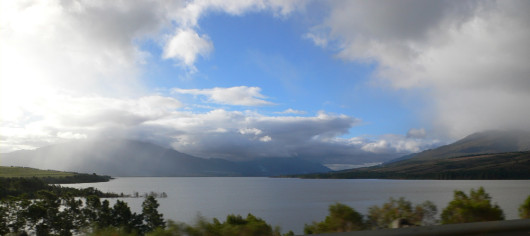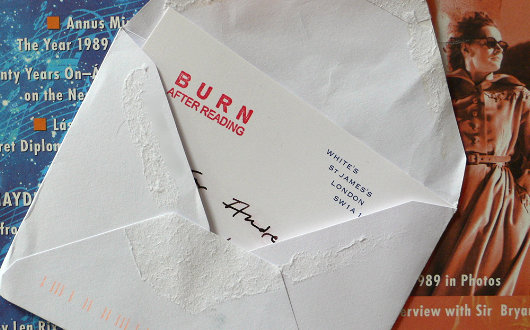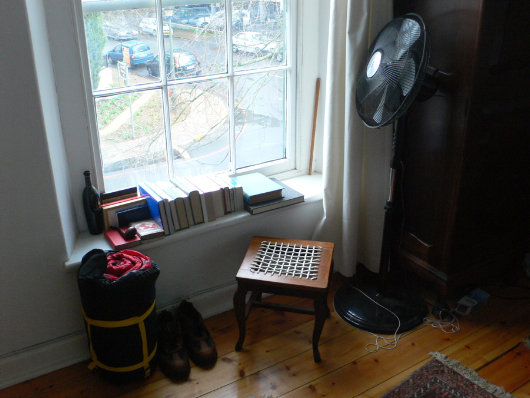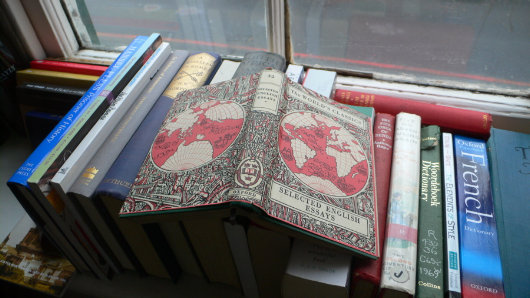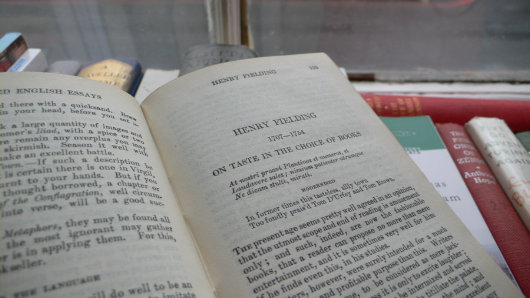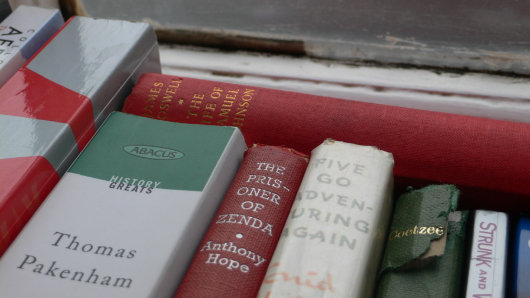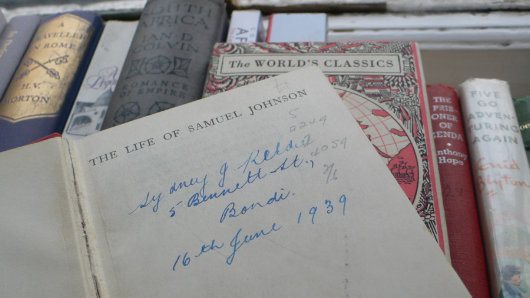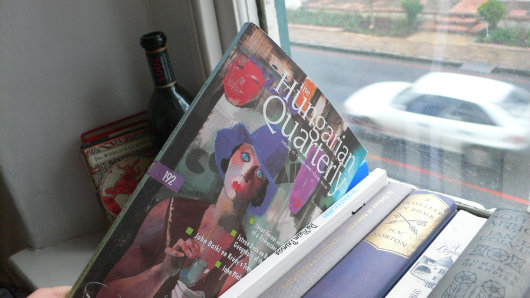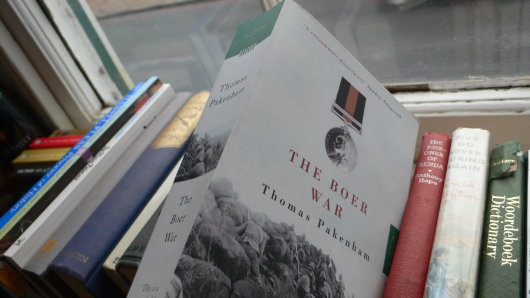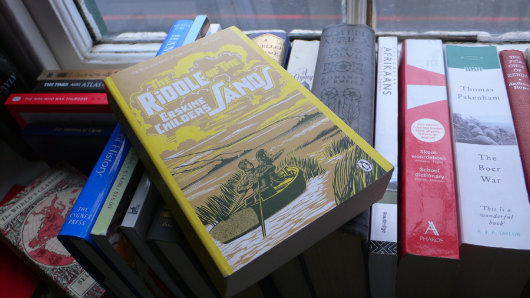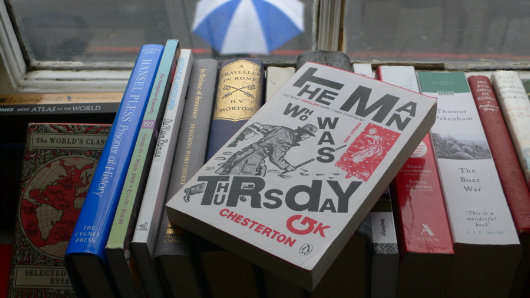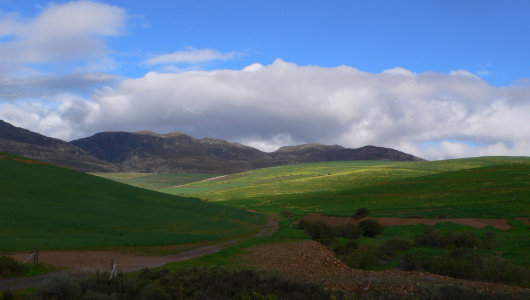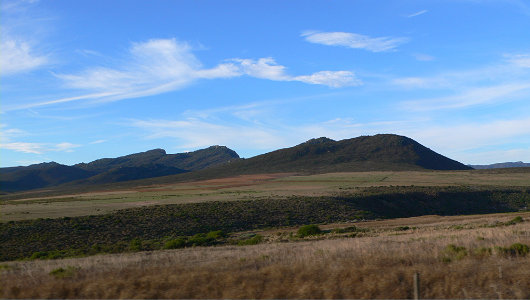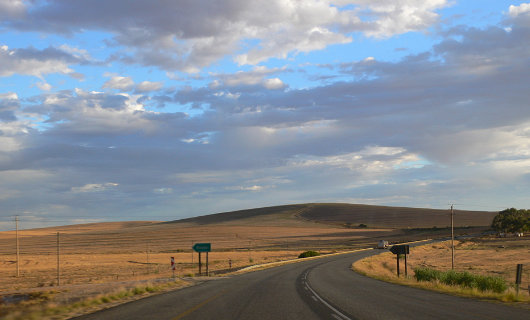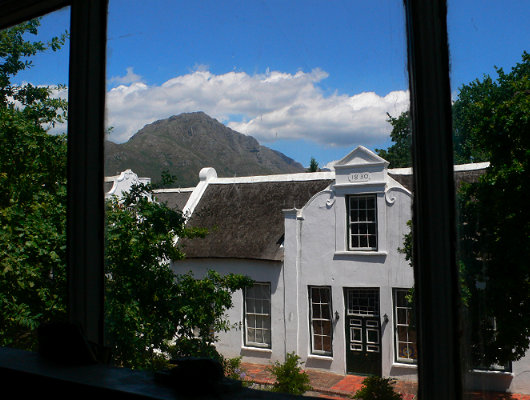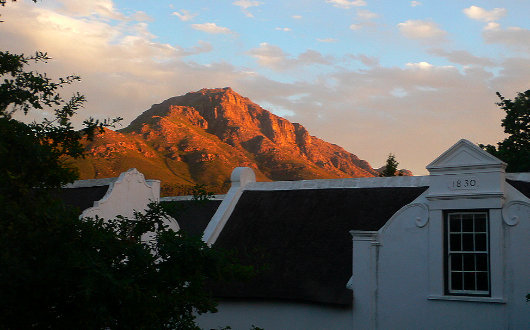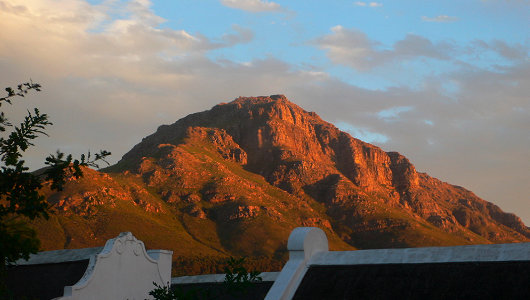Cusack’s Diary
About Andrew Cusack
 Writer, web designer, etc.; born in New York; educated in Argentina, Scotland, and South Africa; now based in London.
Writer, web designer, etc.; born in New York; educated in Argentina, Scotland, and South Africa; now based in London. read more
News
Blogs
Reviews & Periodicals
Arts & Design
World
France
Mitteleuropa
Knickerbockers
Argentina
The Levant
Africa
Cape of Good Hope
Netherlands
Scandinavia
Québec
India
Muscovy
Germany
Academica
Joyce Linton: The Lady with the Voice

Yesterday, in a beautiful sung requiem at St. Agnes, we paid our final respects to our friend Joyce Linton. I had known Joyce for quite some time before I ever actually met her because we tended to sit in the same neighborhood of pews (in the back of the church towards the left) at the 11 o’clock Mass at St Agnes every Sunday. While a schoolteacher by profession, she was also a trained vocal musician, and her voice carried as the congregation belted out our Credos and Glorias. She became known to me as “the Lady with the Voice”, and every so often I would see her making her way towards the church just before 11:00 and, without knowing her name, I would say to myself “That’s the Lady with the Voice”.
Eventually, I got to know Joyce well, and joined the regular tea-drinking crowd of which she was a devoted and prominent member. Vim. Moxie. Determination. Those are the words that come to mind when I think about Joyce, a spirited lady if ever there was one. But she was, also, a woman with a certain style. Think of 1950s New York, swanky, bright, and modern, but still traditional, and never out of date. That was Joyce.
Now, if there was one thing that undoubtedly went along with Joyce’s vim, moxie, and determination, it was that she had an opinion. She enjoyed a vibrant discussion and the interaction of ideas, but she made certain that even if you didn’t happen to share her opinion, you would at least be familiar with it. As it happens, Joyce and I were lucky enough to agree with one another on many things, but by no means all things. More than once did I attempt to refute her position on this, that, or another thing. After the back-and-forth had exhausted itself, she would say, “Well, I don’t think it’s quite as simple as that”, I would shrug my shoulders and say “Perhaps”, and we would sip our tea and rejoin the larger conversation.
She was a woman who was grateful for the graces in her life. She was grateful for the blessings of her family, though it was not without hardships. She was grateful for the magnificent inheritance of centuries of art and culture she was born on the receiving end of. She was a patriot if ever there was one — a proud American, but one with a devoted filial love of Europe, and especially of Italy.
I think the first time Joyce visited Italy was when she did her voice studies in Florence in the 1970s, and she never stopped going back. She had a devotion to Padre Pio and paid her respects to the great saint by pilgrimming to San Giovanni Rotondo. Towards the later years of her life she had a special love and appreciation for summer days spent at Gardone on the shores of Lake Garda, enjoying the intellectual stimulation of the annual summer symposium organized by the Roman Forum. The Italian airs invigorated her Celtic blood and she would return to New York in late summer rejuvenated and refreshed.
She always knew lots of things about New York. You can get great freshly baked bread here. They do a good brunch there. If you really want to do X, then you’ve got to Y at Z on Nth Street. I remember one drizzly November Sunday afternoon Joyce showed me “the best way to cut through Saks” as she and I made our way to the annual Choral Evensong & Flag Service for the Patriotic, Historical, and Hereditary Societies at the Church of St. Thomas, Fifth Avenue.
Joyce loved her job as a high school teacher at Manhattan Center on the Harlem River, just a few doors away from Our Lady of Mount Carmel on 115th Street. Any and all bureaucratic encroachments upon the teaching profession were vociferously opposed by her, and she had an enormous pride when her students did well (especially her girls). Latin was another excuse to spend time in Italy, where she studied the language under the famous Fr. Reggie Foster in Rome. She taught English as well, and was adamant that her students learn important lessons from writers like Orwell and Wilde, rather than a rote set of facts or ideas or quotes. She was always on the lookout for a new way of explaining the old truths to the students in her charge. She loved them, but she also loved her colleagues, and more than once had us praying for this one or that one.
When she was first diagnosed with cancer, many of us prepared ourselves mentally for The End. I think Joyce said to herself “Well I’m not having any of that.” She beat it the first time round (remember what I said about vim, moxie, determination?) to the surprise of many, probably her devoted doctor most of all. She went back to work, and her own hair grew back, allowing her to dispense with the peppy wig she had specially styled. Life, it seemed, returned to normal, for one last Halcyon day before the Hour approached. When the time did appear on the horizon, her descent was rapid. I’m glad I had a chance to see her one last time, surrounded as she was by friends in Lenox Hill Hospital.
Joyce would have loved her requiem, the priest in mournful black trimmed by resplendent gold, acolytes and torch-bearers aiding in the sanctuary, the Dies Irae rising from the choir loft, and those who knew and loved her pleading God’s mercy and quick remission of her earthly transgressions. It was beautiful — as the most beautiful things are — because it pointed towards that Heavenly place from whence our only glories come, where we pray “the Lady with the Voice” will enjoy perpetual light and rest eternal.
Requiescat in pace.
Amen.
The End of India Street
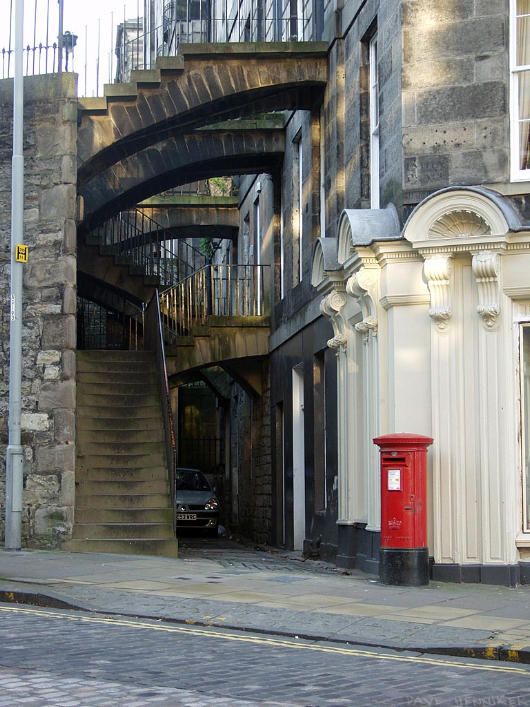
Photograph by Dave Henniker.
Life in the Cape
Some Selections from the Work of Photographer Bernard Bravenboer
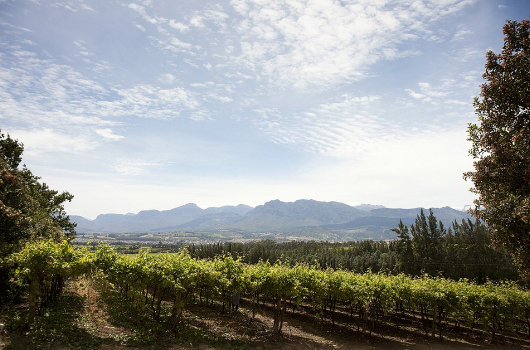
Bernard Bravenboer is a Stellenbosch photographer whose website I stumbled across some time ago. In their vivacity and their variety, Meneer Bravenboer’s photographs capture something elemental about life in the Cape. Here are some selections from his work. (more…)
…en dit is ’n foto van my in Suid-Afrika
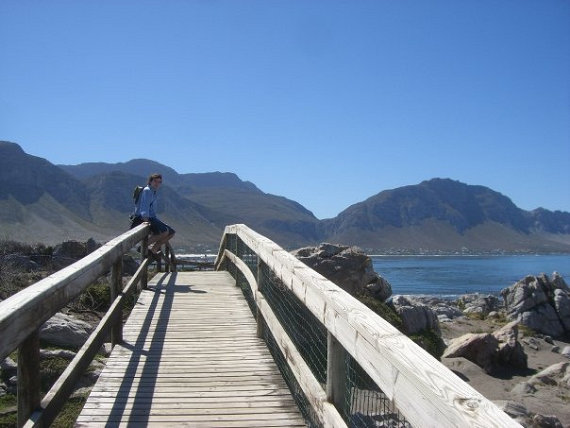
A reader has pointed out that, in all my posts on South Africa, those who frequent this little corner of the web have not seen so much as a single shot of your humble & obedient scribe in that southerly land. Such lack of photographic evidence, our correspondent argues, could provoke a wealth of conspiracy theories locating me, alternatively, within the deep recesses of the Vatican, training a small fighting force in the Salzkammergut, or, somewhat implausibly, in the Democratic People’s Republic of Korea.
(In truth, I have very, very few pictures of myself, as I am usually the one taking the pictures — some of which are electronically submitted for your approval here.)
And so, dear readers, you will find above a photograph of yours truly on one of my trips to Betty’s Bay, that splendid corner of the Cape.
221B Baker Street
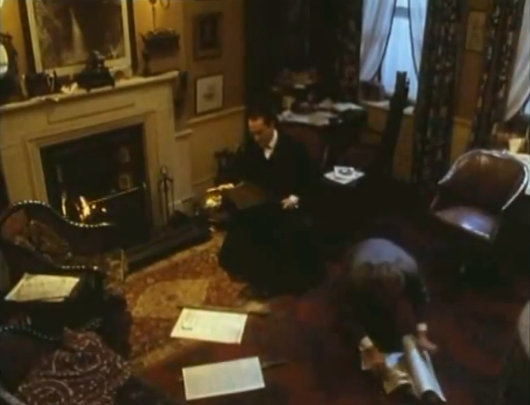
I think the ideal model for bachelor digs must be No. 221B Baker Street from the Granada TV production of Sherlock Holmes (Jeremy Brett’s performance as the title character being his most enduring and remembered role). Needless to say, one would have to have Mrs. Hudson as well, lest one starve to death or suffer the ignominy of microwaved meals.
Novanglian Peregrinations
A journey to the shining city of Saint Botolph, and return
THE PERIOD OF MY removal to South Africa sometimes inclines me to think that time stood still during my absence from the northern hemisphere. It is as if the mental chronicle of my brain simply ceased, and took up writing in a different book, and then went back to the end of the old page upon my return. But time indeed did pass, and many were the old friends and acquaintances with whom we had not combined in some time. Communication was no better than intermittent while exiled in southerly climes, but, freshly returned, the tom-toms were beat and the smoke signals sent to the usual suspicious characters of note. A convocation of cohorts and old confederates was then proposed, to take place in Boston — caput and urbs maxima of God’s own province of New England.
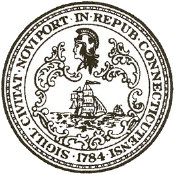 My first stop was actually New Haven, and traversing the border into Connecticut I crossed myself in accordance with ancient custom, invoking the guardian angel of that jurisdiction in the usual pleas for safe travel, easy passage, and the avoidance of traffic cops & parking fines. In New Haven, I attended the meeting of a learned society (composed of both postgraduates & undergraduates) devoted to polite discourse, under the sacred patronage of the Saints Augustine of Hippo and of Canterbury, and the secular patronage of the Anglo-Irish divine Bishop Berkeley. Speaking of the divine, the society’s meeting was preceded by Mass, offered by one of the Dominicans who unofficially tend to the flock of Yale students (the official Roman chaplaincy there having a poor reputation) in an improvised chapel at the club’s quarters.
My first stop was actually New Haven, and traversing the border into Connecticut I crossed myself in accordance with ancient custom, invoking the guardian angel of that jurisdiction in the usual pleas for safe travel, easy passage, and the avoidance of traffic cops & parking fines. In New Haven, I attended the meeting of a learned society (composed of both postgraduates & undergraduates) devoted to polite discourse, under the sacred patronage of the Saints Augustine of Hippo and of Canterbury, and the secular patronage of the Anglo-Irish divine Bishop Berkeley. Speaking of the divine, the society’s meeting was preceded by Mass, offered by one of the Dominicans who unofficially tend to the flock of Yale students (the official Roman chaplaincy there having a poor reputation) in an improvised chapel at the club’s quarters.
Mass was followed by port, smoking, and some cheese & finger foods for the hungry souls. I mentioned to a friend that the Choco-Leibniz cookies on offer were my favourite, the official state biscuit of the house of Cusack. “Of course they are,” the wag responded. “Choco-Leibniz are the best of all possible biscuits!” (Some jokes are so bad that the resulting chortles are both inevitable and involuntary.)
Then, the subject at hand. This meeting was convened to discuss the recently announced Apostolic Constitution establishing “personal ordinariates” to ease the reception of Anglican Christians into full visible communion with the Pope. The assembled members were by no means only Catholics, but with a significant portion of Episcopalians, and the odd Calvinist for good measure. A brief paper by an entrenched Anglican was read, and the members responded and discussed the matter with courtesy and depth as the fire crackled in the background. Which groups are likely to take advantage of the coming ordinariates? Which are least likely? Was this chiefly a pastoral move? What do the Orthodox think? What will the reaction be outside North America? All these questions and many, many more were raised and, so far as possible, answered.
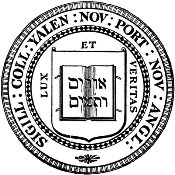 The formal discussion was concluded with the invocation of the two Augustines and a toast to Bishop Berkeley. A number of members remained by the fire while others dispersed for other events. The weekend beheld the 75th Anniversary of the Yale Political Union, and so the constituent parties of the YPU were all having events for their members and alumni. (From what I can understand of the YPU’s right-leaning parties, the Conservative Party is for Republicans, the Tory Party is for decadent Anglophiles, and the Party of the Right is for conservatives.)
The formal discussion was concluded with the invocation of the two Augustines and a toast to Bishop Berkeley. A number of members remained by the fire while others dispersed for other events. The weekend beheld the 75th Anniversary of the Yale Political Union, and so the constituent parties of the YPU were all having events for their members and alumni. (From what I can understand of the YPU’s right-leaning parties, the Conservative Party is for Republicans, the Tory Party is for decadent Anglophiles, and the Party of the Right is for conservatives.)
Following the procurement of beer and the ordering of pizza, the consumption of both, and the extinguishing of the fire, it was time to retreat for the evening to the splendid old Victorian house where a number of folks live. It’s one of those old, solidly American homes, with a swinging chair on the porch, splendid wood detailing inside, and pocket doors between the receiving rooms. Dotted around an old dining room table, more news and rumours were exchanged between the inhabitants and guests as the remnants of a bottle of Macallan was polished off. The Choco-Leibniz joke was repeated for those who were not in attendance before. A South Carolinian’s reaction to the health-food movement was recalled: “They won’t buy an egg if it ain’t free-range but they put on all manner of uh-koo-tra-mints so as not to conceive!” One of our friends, an Englishman, treated us to a rendition of “Come Thou Font of Every Blessing” on the banjo, and we were informed that a group of Yale Divinity students were officially reprimanded for having a watermelon-eating competition. (Watermelons often feature in stereotypical caricatures of American Blacks, and thus are apparently forbidden by the Monotony Monitors). We went on in such manner until the wee hours, when the assembled finally adjourned to bed.
Then the morning: breakfast — pumpkin pancakes from S.O.’s wife before she popped off to riding practice — before A.L. and I combined to continue the journey onwards to the City of Saint Botolph, Boston. The city’s name comes from the Lincolnshire town of Boston, itself a contraction of “Saint Botolph’s Town”. Many of the Puritans hailed from the East Midlands, and it was John Cotton, the controversial Vicar of Saint Botolph’s Church in Boston, who encouraged many separatist radicals to emigrate to the Massachusetts Bay Colony in New England. The New-World town of Boston was founded in 1630, and named in honor of the place associated with Cotton, who himself emigrated three years later. The Church of Saint Botolph is the most prominent landmark of old Boston, founded in 1309 and famous for its late-fifteenth-century English Perpendicular lantern tower. As coincidences go, the design of Harkness Tower at Yale University in New Haven is inspired by that of Saint Botolph’s in old Boston. New Haven’s name also harks back to the River Haven which flows just some thirty-odd feet from the great tower of Saint Botolph.
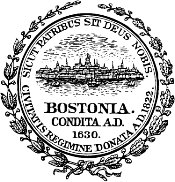 A New Yorker is always of two minds about Boston. We consider it a somewhat uppity member of our northern periphery and despise the attitude of some of its lowlier inhabitants (the sporting fans of red hosiery), but the old Knickerbocker can’t help but envy the skill and ability with which the Bostonians have preserved so much that has been utterly destroyed in New York. Boston, despite its politics, might just be the most conservative town in the American Republic. During our stay in Boston, we never left the immediate vicinity of Beacon Hill and Back Bay, except for one foray into Chinatown for dinner. The architecture is splendid, traditional, and vernacular, and the streets are uncrowded compared to the vast hordes that swarm around Manhattan.
A New Yorker is always of two minds about Boston. We consider it a somewhat uppity member of our northern periphery and despise the attitude of some of its lowlier inhabitants (the sporting fans of red hosiery), but the old Knickerbocker can’t help but envy the skill and ability with which the Bostonians have preserved so much that has been utterly destroyed in New York. Boston, despite its politics, might just be the most conservative town in the American Republic. During our stay in Boston, we never left the immediate vicinity of Beacon Hill and Back Bay, except for one foray into Chinatown for dinner. The architecture is splendid, traditional, and vernacular, and the streets are uncrowded compared to the vast hordes that swarm around Manhattan.
Our home for the time being was a handsome apartment in Beacon Hill, well-decorated and amply supplied with books and booze. A.L. and I parked the car in the garage under Boston Common, and were met by our close friend I.M.C., who is the lynchpin uniting this social circle. I.M.C. hails from north of Boston, towards Gloucester, but had arranged for his friend T.L.G. to host us in his flat overlooking the Public Garden. Upon arriving we were offered generous cups of tea, ginger snaps, and sliced mango and conversed for quite some time before we decided upon a light Saturday afternoon jaunt around Back Bay and Beacon Hill.
T.L.G. explained the creation of Back Bay from landfill as the four of us swaggered down Commonwealth Avenue, be-tweeded on this autumn day. We popped into the Boston Public Library just before closing, and gazed out onto Copley Square that was once the epicenter of the city. The square is or was, at various times, home to the Public Library, Old South Church (Cong.), Trinity Church (Episc.), the Massachusetts Institute of Technology, the Museum of Fine Arts, and the Copley Plaza Hotel. Sadly, it is now disfigured by the looming bulk of the John Hancock Tower, a modern skyscraper by I. M. Pei that is the tallest building in New England. It was so shoddily constructed that entire panes of glass began to fall off after it was completed, eventually forcing the owners to replace ever single pane of glass within just a few years. We swung by the Church of the Advent where our host is a parishioner and whose Lady Chapel and rood cross were designed by Ralph Adams Cram. Just after we exited the Church, we were introduced to the Rector, who was just coming home from the wine shop.
Returning to the apartment, it was time for drinks. The gin flowed like wine, and it wasn’t long before we were joined by J.T., A.R., and M.D. All manner of things under Heaven were discussed, from the latest exploits of mutual friends, to matters of state, and of course church affairs (this is a half-papist, half-’piskie crowd). Said discussions continued around a table for seven at the Taiwan Café in Boston’s Chinatown. (Good to support Nationalist China, but it did require crossing Boston in the rain). Our dinner of pork, dumplings aplenty, soup, and tea finished, we progressed to a certain private club for more drinks. M.D. treated us to his side-splitting imitation of Katharine Jefferts Schori and Peter Akinola having an argument before the evening finally came to it’s conclusion.
Sunday morning, breakfast of tea, sausages, and proper porridge. Despite all the previous evening’s drinks, not so much as a hint of a hangover. Stood on the balcony overlooking Charles Street in the unseasonable warmth and began to appreciate Boston’s existence. I.M.C. cordially invited us to visit his home town of Beverly, a good New England town north of Boston and on the sea. Lunch, evening Mass, dinner, more good conversation throughout. But an early morning’s rise on Monday, to make it back south home to New York, ending a fine and invigorating peregrination through at least part of New England.
The Old Slave Quarters
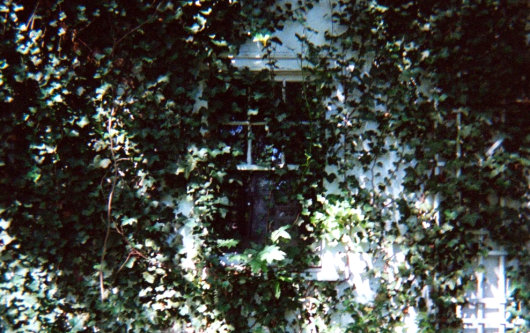
A child’s imagination can transform the humblest construction of pillows into a fortification to equal the Krak des Chevaliers. On the grounds of my old school, there was a shack in a state of advanced dilapidation which I decided was an old slave cottage. I knew there was absolutely no chance of this being factually accurate — it probably didn’t date from any earlier than the 1910s — but one could easily picture Aunt Jemima living an abject poverty within its slowly crumbling walls. The shack was in one of the more peaceful corners of the school grounds, and there was an old rope hammock nearby, to which I would occasionally repair for a brief nap after a lunch of particular vivacity.
Despite its advanced deterioration, I found it a charming little structure, and it always saddened me that every map and plan I shuffled through in the Headmaster’s Office featured the parenthetical “(to be demolished)” atop the building’s outline. Indeed, it may have been destroyed already. (more…)
Diary
I have been spending the past few days in a flat at the corner of Holland Park Avenue and Portland Road, in this verdant corner of the capital. The flat is clean, capacious, and handsome, but terribly modern. Indeed, it is so modern that it will soon be old; it will not exhibit the old age of the time-honoured and true, but rather the tawdry oldness of what had only recently been new. Pedantic students of interior design will study photos of it and discern “2008 I’d say… no! 2009!” But for now, it is still new, still fresh, and so, like a tomato fresh for the plucking, we will enjoy it while its moment is precisely appropriate.
Until now, I hadn’t much knowledge of this part of London, but find it a happy place to be in August. The weather has been mild and kind, and I spent part of the afternoon reading de Maistre — the St. Petersburg Dialogues — in the formal garden in Holland Park. The avenue itself is tree-lined, or rather tree-engulfed, such is the plentiful shade, and has a small selection of cafés: the Paul boulangerie which is becoming omnipresent, and the Valerie patisserie, both chains. Cyrano, at No. 108 Holland Park Avenue, is much preferred, and I decamped there for a light breakfast with a copy of the Scotsman from the local newsstand (the one on Ladbroke Grove, rather than the smaller one by the tube stop) while avoiding the miserable Irish cleaning lady who returns the modern flat to its pristine whiteness every Thursday morning.
Then to the Royal Academy, for the Waterhouse show. What an interesting artist! His earlier works so precise in detail and, for lack of a better word, academic. Yet in his later pieces, you can find a certain willingness to obfuscate, perhaps an admission that reality is not quite so precise and that the most accurate portrayal of reality requires a few lines to be blurred. Faces, and indeed all forms, remain clear throughout, but the architectural coldness of the earlier works on display gradually evolves to a more fluid depiction of Greek mythos and Keatsian tales. Waterhouse can vary in his details from the almost photographic to verging on impressionism in a single painting. Was that his intention? It was certainly the result.
My viewing companion — an old university friend — and I agreed that throughout all the themes portrayed by the artist one can’t help but feel an overwhelming Victorian-ness. Is this ex post facto because we know Waterhouse to be an High Victorian artist, or is there actually some inherent quality in the works that calls to mind that era? Very difficult to say, but those in London should not miss this exhibition of a popular yet under-appreciated artist — the Jack Vettriano of his day.
Who is in London in August anyhow? The text messages sent out, and their replies promptly received. “I’m in Geneva! Will be in Luxembourg next week if you’re on the continent.” I am not and will not be on the continent. “I have been unexpectedly called to Africa.” Well I’ve just come from there, though not the Sudan thank God. “You’re welcome to come to Gozo between the 5th and 15th for a pleasant, quiet holiday.” I will have returned to New York by then, alas. “Am up north in Lancashire; you’re welcome to come and visit, sample our recusant history!” Just haven’t got the time, alas.
But while many have escaped for the month, many yet remain. An afternoon drink at Rafe’s, with Fr. Rupert and Alex Williams. The Carlton is being refitted, so it was drinks at the East India Club instead with another university friend, during which we concur that office jobs are the absolute pits and we should have studied agriculture with the country girls at Cirencester rather than getting tawdry MAs in Scotland. There is no greater affirmation of the consequences of original sin than the omnipresence of the 9-to-5 office job.
Astute observers of this little corner of the web (if indeed we can use the plural for such a subset of the earth’s population) will recall an incident over two years ago now in which a certain Jack Russell terrier became rather more involved with my lower leg than I had envisioned was ideal. The dog, which goes by the name of Cicio Stinkiman, had noticed me playing with the only seeing-eye-dog in Scotland that knows how to genuflect and resented the attention I was paying to the bitch, to whom he obviously professed some attachment, ran up, and bit me in the calf.
You can imagine my surprise when I learnt that the beast in question is actually now not only living in London but actually residing in the Oratory. Indeed I saw the beast from a distance while waiting on Brompton Road for the Friday evening mass last week. His owner graduated from university (in Scotland, like all the wisest people) two years ago now but his mother banned poor Cicio Stinkiman from the German palace he might otherwise call home, perhaps informed along the voluptuous grapevines of Europe of the horrendous incident in which the beast had taken an unwelcome interest in my lower leg.
I am being far too unfair to poor Cicio, for he did apologise, and looked up at me with terribly apologetic eyes. Admittedly, that might’ve been because his master stood nearby holding a rolled-up copy of the Catholic Herald most threateningly. Still, pity the poor ignorant beasts. They have no conscience, and thus no real malice. Only we humans, with the freedom we abuse so easily, can claim that dubious achievement.
Good to be back
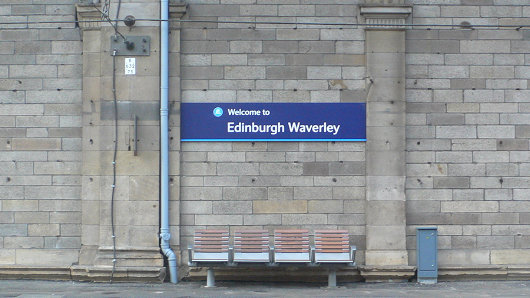
Sad to leave it. (I’m in London now).
From the Number 23 Bus
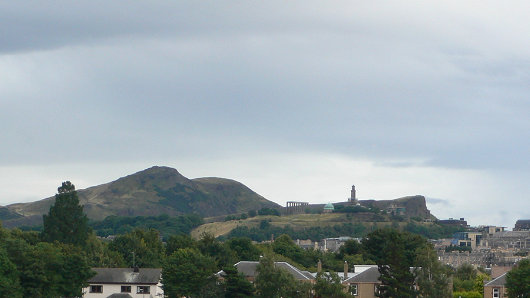
A view of Edinburgh from the top of the no. 23 bus. (more…)
The End of the Affair
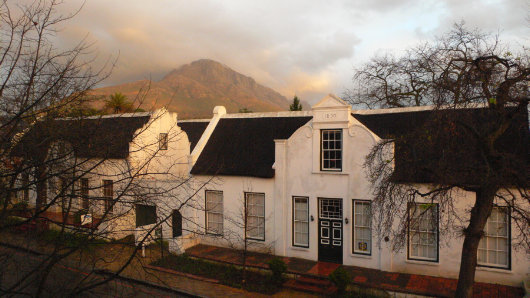
HOW CAN ONE possibly summarize a portion of one’s life? Those first warm breaths of African air as I stepped off the plane at Cape Town International. The stern-faced mustachioed driver who drove me to Stellenbosch, the town that became my home, on my first day on the African continent. My strongest memory is just pure sunlight. I had flown down from the deepest winter of the northern hemisphere, and the sun’s warm embrace was a welcome change. As we entered the valley of Stellenbosch, my solemn driver broke the silence and asked what business was taking me there. Learning that I came, at least in part, to study Afrikaans, his dour visage was suddenly enlivened, and he earnestly gave every assurance that I would enjoy myself in Stellenbosch immensely.
The town itself is handsome, full of white-washed walls and pleasant streets lined with old oak trees, some planted by that Dutch governor of old, Simon van der Stel. He gave the town both its name — Stellenbosch, van der Stel’s wood — and its other moniker, Eikestad, the city of oaks. The most remarkable feature of the town, however, is the beautiful range of mountains that flank it on either side. My window happened to look out on Stellenbosch mountain itself, and I admit a certain territorial feeling towards that berg has formed through the several mornings, noons, and nights it has stood watch over me.
But pleasures though there are in Stellenbosch — a stroll the Botanical Gardens, a pint at De Akker, dinner at Cognito where they know my “usual” Tanqueray-and-tonic — even more awaits the Stellenboscher who ventures further afield. I went as far as Lüderitz in Namibia, one of the furthest extremities of the old German empire. But nearby Cape Town itself provides enough to keep the ardent traveller intrigued. Table Mountain, whose looming presence over the city frames the moederstad perfectly. Further along to the pleasant sands of Clifton’s beaches, the port of Simon’s Town, and down to the end of the Cape itself — the end of Africa, where two oceans meet.
And across False Bay to Rooiels and Betty’s Bay, to the Kogelberg reserve where the hiker’s efforts are rewarded by the seclusion of a splendid little swimming hole. Floating to and fro in the little river pond, being sung to by fair Finnish maidens — there are worse ways to spend a summer’s afternoon. But it’s also glorious to be alone in Kogelberg; to hear the silence of the dead summer, outstretched arms floating along, grazing the tall grass and the heather beside the way. The open, breezy country and the quieter nooks lodged between, whose heat betrays their stillness of air. Barely any sound but the crunch of foot upon path, the wind rustling through the plants, and the odd chirp of insect here and there.
And where else? To Wupperthal, where the barefoot coloured children play happily in the eucalyptus-lined street leading to the old Rhenish mission. To Kakamas, where the farmer invites us to lunch with his family, and guides us around just a few of his 600,000 acres. To Hermanus, spending two glorious hours clearing invasive plant species from a field before breakfast — that damned Ficus rubiginosa! To Greyton for a winter’s lunch beside the fireplace, and to Genadendal, the “valley of Grace”, the queen of the Moravian missions.
And with whom? Ah, the easy acquaintances of a university town. Friends from class, friends from the pub, friends from the bistro, friends of friends, and friends of friends of friends, who all end up as friends. To the beach on Friday? The cinema tonight? The pub quiz on Tuesday? A coffee tomorrow afternoon?
The people, more than anything, make the deepest impression — both the South Africans and my fellow travellers. Good times shared and conversations enjoyed. Some surprising friendships spring forth from the unlikeliest of places and the most scant of connections. And stories are shared of varying experiences. Poor Ralf almost getting done in by that hippo in the Kalahari! The intervarsity match — another victory for die Maties. And the second test match against the Lions — Morne Steyn, that kick! A genial cup of tea in a well-kept house in Oranjezicht as the resident explains how many times she’s been burgled. The Kayamandi girl whose father disappeared long ago, whose stepfather abuses her every night, and whose mother is entrapped into acquiescence by poverty. A student dies from swine flu — a first in South Africa. Another is murdered by the obsessed friend of her older brother. The police beat the suspect so badly he cannot appear in court. The headline in the Eikestadnuus proclaims “Vyfteen weeks, vyfteen moorde” — fifteen weeks, fifteen murders in this pleasant little corner of the Cape. The latest exhausted statement from Kapt. Aubrey Marais of the Stellenbosch police. An email from the university rector: male students are reminded not to allow girls to walk home unaccompanied at night. In the face of all this, ordinary lives continue unintimidated.
This country has a tendency to seep into the veins, to get under people’s skin. There is no brief affair with South Africa. Her own sons and daughters dot the globe — thousands are in London alone — but they earn their keep abroad while they yearn for the land they left. (“They just miss having servants” half-jokes the farmer’s wife.) Some do leave forever, but many more come home after a few years. My time is up, I leave South Africa today, but I can’t help but think the affair is not over, even if it only continues from afar. It is difficult to escape the lure of this deeply troubled, deeply blessed land.
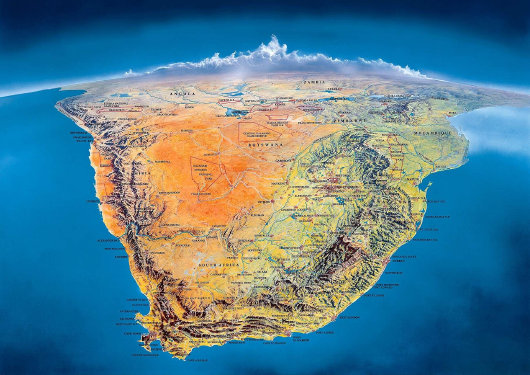
Some reading notes
ROBERT O’BRIEN, IN a deliberately provocative gesture, once said in conversation that he pitied America for not having any literature. Preposterous! was my natural response. We have Chaucer and Shakespeare and Mallory and Dickens! Yes, you Britons have them too, but you will have to share, I’m afraid. To try to separate America from the English greats is the equivalent of forbidding a son from taking pride in his family’s long and illustrious history. He may not be the eldest male descendant, but does this mean he must deny his heritage? Of course not. Naturally, like the Scots and the Irish we have our own subset of English literature — Mark Twain, F. Scott Fitzgerald, Flannery O’Connor, and J.D. Salinger come to mind — and there are even a few crossovers such as Henry James and T.S. Eliot.
The idea of doing a degree in English or in any literature has always seemed unattractive to me, though I by no means advocate the abolition of English departments. Perhaps it’s because I rarely found English a compelling subject in high school, though I did have some extremely talented teachers: The P (as she is known), as well as Mr. Leahy. I am one of those no doubt millions who wishes he had actually read all those books he supposedly read for class at school. I did enjoy Sophocles, and Homer too, but I did not really get into Flaubert (I intend to revisit him). Crime and Punishment I soaked up at the time, but have since forgotten.
How tiresome it must be, as a formal student of literature, to be forced to answer questions about works you have read. I wonder if there should be two tracks within universities: one for gentlemen, who merely seek to learn, and another for budding academics, who need proof they’ve learnt something. Some books have taken years (and multiple readings) to truly sink in, so it seems preposterous to arbitrarily require a succinct series of answers to examination questions at the end of a term.
Idea-driven novels seem foolish to me as well. In New York, I knew a Frenchman, not much older than myself, who (I discovered) was in the midst of writing a novel. Intrigued, I asked him one day what the novel is about. He paused for a few moments, sat back, and slowly tapped his finger thrice on the table in thought, and said “Stratification”. Well! Call me a simpleton but I would have preferred “a guy, a girl, a plot, an affair, schoolmates, a day, a week . . .” anything, but “stratification”?
Well, he is writing in French, and if you are going to write an idea-driven novel, it’s probably best to do it in French.
What have I been reading lately? A few months ago I finished Erskine Childers’ The Riddle of the Sands — an absolutely cracking book. It was late in the African summer, and I was perched appropriately on the sands of Kogelbaai — one of the most stunning beaches in the Cape. What’s more, it was a weekday afternoon, and so the strand was abandoned but for our small party, so we sat, read, napped, explored the rocks, and enjoyed the beauty of our surrounds. Another cracking read was Chesterton’s The Man Who Was Thursday. The author subtitled his book “A Nightmare” and it had moments of utter fear and dread, but also, being Chesterton, moments of ridiculous farce and hilarity: a fascinating insight into the mind and mentality of a jovial and saintly man.
H.V. Morton, the man who convinced me to come to South Africa with his In Search of South Africa, showed me the Eternal City with A Traveller in Rome, and I am so tantalizingly close to finishing that magnificent work of Thomas Pakenham (now Lord Longford, since the death of his father), The Boer War. Pakenham is an historian beyond compare. I began Kristin Lavransdatter to great enjoyment, but am waiting till my return to New York to complete it. I started The Prisoner of Zenda while travelling in Namibia and finished it on Pentecost weekend. Boswell’s Johnson I found an excellent little india-paper edition of in a tiny back-alley shop in Wells last year (we ran into Michael Alexander on the street) and I’ve been pottering through it bit-by-bit. On the recommendation of Stefan Beck I picked up J.P. Donleavy’s The Ginger Man but found it obsessively vulgar and, worse, boring, so returned it to the goodly people at the Universiteit se biblioteek.
I still have out from the library a handsome, handy, small German printing of Legends of the Rhine (translated into English). I like small books, books you can easily fit in the pocket of a field coat and whip out at a moment’s notice. At a reception in a New York gallery some time ago, I learned from John Derbyshire that the determining factor of the old Penguins’ size was that it would fit in the front coat pocket of a British Army officer. The new size of Penguins are much too large to carry about as emergency reading, which makes me very glad that they’ve brought back the older, smaller size.
Penguins aside, I still prefer those shorter, fatter editions printed on thinnest india-paper. Jocelyn, my cook at university, gave me such a copy of The Pickwick Papers (inscribed “To Andrew Cusack — one of the most Pickwickian individuals I have ever met”) for my birthday one year, and it is one of the dearest editions I own. Does anyone print on india-paper anymore? I suspect not, and more’s the pity. Michael Wharton (better known as Peter Simple) noted shortly before his death how difficult it was becoming to obtain sheets of foolscap in London. Thus passes the glories of the world…
Betty’s Bay
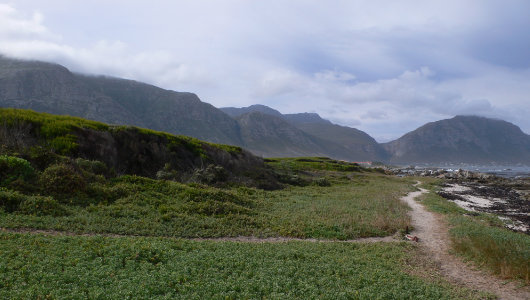
Travelling down the east side of False Bay, through the happy town of Rooiels, past Pringle Bay, and around Cape Hangklip sits the little village of Betty’s Bay. Nudged between the waters of the Indian Ocean and the rugged mountains of the Kogelberg, this is one of the most beautiful corners of the Cape. At the same time, it is just sixty miles (as the crow flies) from die moederstad itself — Cape Town. In days long since past, Betty’s Bay and the surrounding area of the Overberg were the hiding places for runaway slaves, sailors deserting their vessels, and smugglers of every kind. The Overberg takes its name because it is over the Hottentots Holland mountains from Cape Town — just outside the immediate purview of the earnest authorities in that swarming port, the “tavern of the seas”.
Search
Instagram: @andcusack
Click here for my Instagram photos.Most Recent Posts
- Faithful Shepherd of the Falklands April 8, 2025
- Articles of Note: 8 April 2025 April 8, 2025
- Proportionality Destroys Representation April 8, 2025
- Sag Harbor Cinema March 26, 2025
- Teutonic Takeover March 10, 2025
Most Recent Comments
Book Wishlist
Monthly Archives
Categories

